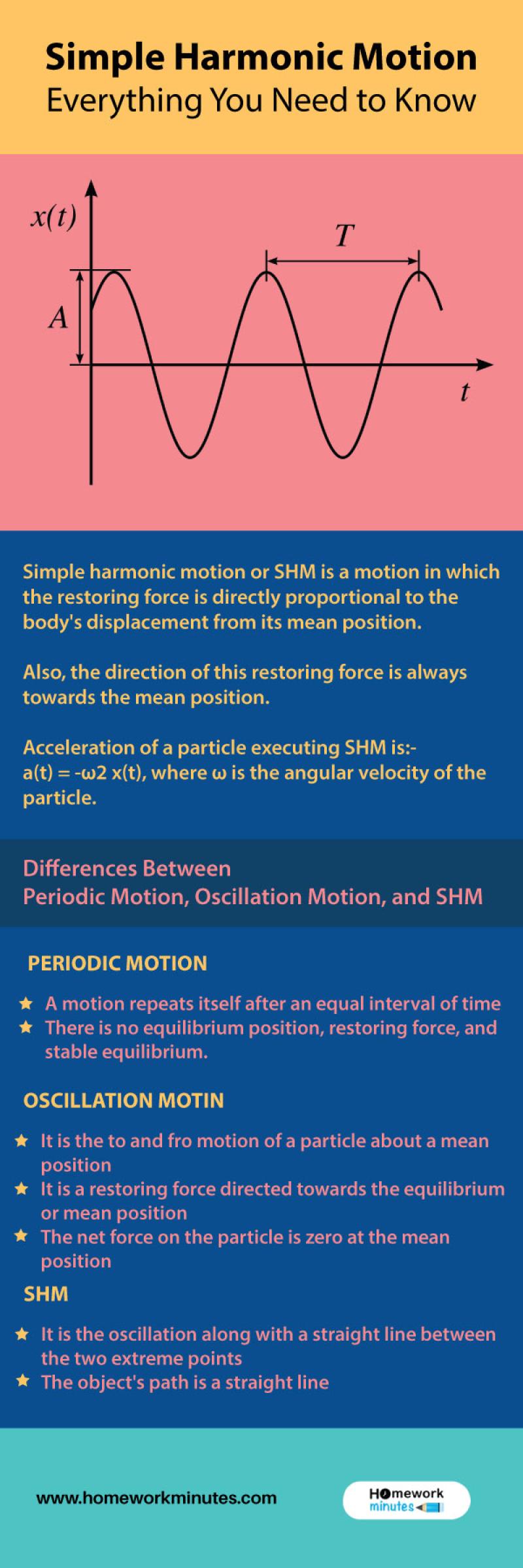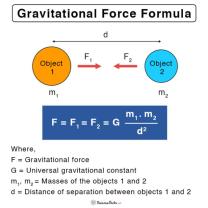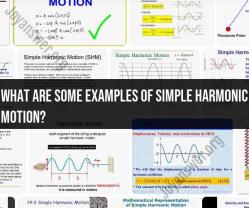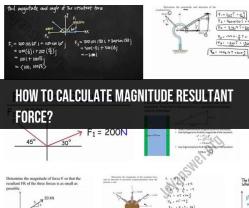Why is simple harmonic motion so important?
Simple Harmonic Motion (SHM) is a type of periodic motion that occurs when a restoring force proportional to the displacement acts on an object, pulling it back towards a stable equilibrium position. This motion is characterized by a sinusoidal (sine or cosine) oscillation and has significant practical importance in various fields. Here are some reasons why simple harmonic motion is considered important:
Understanding Physical Phenomena:
- SHM is a fundamental concept in physics and provides a basis for understanding various physical phenomena. Many real-world systems exhibit harmonic motion or can be approximated as such, including pendulums, springs, and vibrating strings.
Mechanical Systems:
- Simple harmonic motion is crucial in the analysis and design of mechanical systems. Springs and pendulums, which are common in engineering and physics, often exhibit SHM behavior. The study of SHM helps engineers design structures and mechanisms that involve oscillations.
Wave Theory:
- Simple harmonic motion is closely related to wave theory. Waves, including sound waves and light waves, can be described in terms of harmonic oscillations. Understanding SHM is fundamental to explaining the behavior of waves in different mediums.
Resonance Phenomena:
- Resonance, which occurs when a system is driven at its natural frequency, is a direct consequence of simple harmonic motion. Resonance is exploited in various applications, such as musical instruments, where the natural frequencies of strings or air columns produce harmonic sounds.
Electrical Systems:
- Simple harmonic motion has applications in electrical circuits, especially in the study of alternating current (AC). AC voltage and current can be modeled using sinusoidal functions, and the principles of SHM are relevant to the analysis of electrical systems.
Optical Devices:
- SHM is applicable in the study of optical devices. For example, the motion of electrons in atoms can be modeled using harmonic oscillations, contributing to the understanding of the behavior of light and electromagnetic radiation.
Control Systems:
- Understanding simple harmonic motion is crucial in control systems engineering. Systems with oscillatory behavior, such as those involving feedback and control, can be analyzed using concepts derived from SHM.
Medical Imaging and Diagnostics:
- In medical imaging, the principles of harmonic motion are used in techniques like ultrasound. Understanding the behavior of waves and oscillations is essential for interpreting images and diagnosing medical conditions.
Seismology:
- Seismic waves generated during earthquakes exhibit harmonic motion. The study of simple harmonic motion is important in seismology for understanding the characteristics and effects of seismic waves.
Clocks and Timekeeping:
- The oscillations of pendulums in clocks exhibit simple harmonic motion. The regular and predictable nature of SHM in pendulum motion has historically been employed in timekeeping devices.
In summary, simple harmonic motion is a foundational concept in physics and engineering with broad applications. Its principles are essential for understanding and modeling a wide range of natural phenomena, from mechanical systems to waves, and its practical significance extends across multiple scientific and technological disciplines.
The Allure of Simple Harmonic Motion: From Fundamentals to Everyday Life
Simple harmonic motion (SHM) holds a special place in physics, not just for its elegant simplicity but also for its widespread presence in real-world phenomena. Let's delve into its significance and practical applications:
1. Why Fundamental?
- Basic Building Block: SHM serves as the foundation for understanding more complex oscillatory motion, found in waves, pendulums, and mechanical systems.
- Mathematical Simplicity: Described by a straightforward sinusoidal equation, SHM allows for clear analysis and prediction of its behavior.
- Wide Applicability: Its principles apply to diverse fields like acoustics, optics, mechanics, electronics, and even biology.
2. Practical Applications:
- Pendulums: From grandfather clocks to earthquake sensors, pendulums rely on SHM for accurate timekeeping and measurement.
- Springs: From mattresses and car suspensions to catapults and measuring instruments, springs use SHM for cushioning, vibration control, and energy storage.
- Sound Waves: Musical instruments and speakers generate sound waves through the SHM of vibrating membranes and diaphragms.
- Radio Waves: Wireless communication devices like radios and antennas utilize SHM to transmit and receive electromagnetic waves.
- Atomic Oscillations: Even on the microscopic level, atoms vibrate with SHM, playing a crucial role in molecular bonds and chemical reactions.
3. Technological Advancements:
- Tuning Forks: Used in various industries for calibration and vibration analysis, tuning forks rely on the precise frequency of SHM.
- Vibration Isolation: SHM principles are used in suspension systems and shock absorbers to isolate sensitive equipment from unwanted vibrations.
- Precision Instruments: From optical interferometers to atomic clocks, SHM forms the basis for high-precision measurements and timekeeping technologies.
- Microscopes and Telescopes: The design of lenses and mirrors utilizes SHM properties to focus and analyze light waves, enabling us to explore the micro and macrocosmic worlds.
- Medical Imaging: Techniques like ultrasound and magnetic resonance imaging utilize SHM principles to visualize internal structures and diagnose medical conditions.
4. Real-World Examples:
- The swing set in your local park: The swinging motion of a child on a swing exemplifies SHM, with the period and amplitude determined by the length of the ropes and the initial push.
- The tuning fork you use in music class: Striking a tuning fork creates vibrations that follow SHM, producing a characteristic tone with a specific frequency.
- The sound waves you hear when someone speaks: Vocal cords vibrate with SHM, generating sound waves that carry the information of our voice.
- The ripples on a still pond: Dropping a pebble into water creates circular waves that propagate through the surface, exhibiting the characteristics of SHM.
- The spring in your car suspension: As you drive over bumps, the car's suspension absorbs the shock using the SHM of the springs, maintaining a smooth ride.
5. Role in Engineering and Design:
- Bridge and Building Design: Understanding SHM helps engineers design structures that can withstand vibrations caused by wind, earthquakes, and other forces.
- Machines and Tools: From saws and drills to engines and generators, the design of moving parts often incorporates SHM principles for efficient operation and vibration control.
- Microelectromechanical Systems (MEMS): Tiny devices used in smartphones, medical implants, and other applications rely on the precise control of SHM for their functionality.
- Robotic Motion: Designing robots with smooth and precise movements often involves the application of SHM principles in their actuators and control systems.
- **Sustainable Energy: ** Wind turbines and wave energy devices harness the power of SHM in wind and waves to generate electricity.
Simple harmonic motion may seem like a theoretical concept, but its underlying principles permeate our everyday world. From the familiar swing set to the complex technologies underpinning modern life, understanding SHM empowers us to appreciate the intricate dance of forces that shape our universe.












